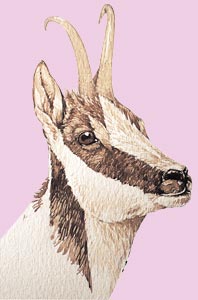gipuzkoakultura.net





Two pieces are of particular importance: the bird bone of Torre and the Ekain sandstone plaquette, which are amongst the masterpieces of European palaeolithic art mobilier.
Among the decorated bones discovered in digs in Gipuzkoa, one of the most important was unearthed in the small cave at Torre, in Oiartzun. Torre is a small uninhabitable cave, which was used as a hide by hunters in several pre-historical periods. The bone is a small cubitus from a gannet – a Nordic sea bird which can still be found on these coasts, although it was once much more common. The diaphysis and part of the proximal epiphysis of the bone remain, but the distal is missing. The remaining piece measures 18 centimetres in length.
This bone forms a perfect miniature and contains the following carved figures: a deer, a horse, a chamois, two ibexes, a urus [or aurochs] and an anthropoid. There is hardly any overlap between the different figures. They are all depicted in profile, except for the two ibexes, whose heads are shown face-on, as is common in palaeolithic art.
There is also a series of symbols including straight lines, zigzags and dots, covering the bone from one end to the other.
The animal figures are highly realistic. If we look, for example, at the head of the deer, we see that its mouth is open, as if it were braying and the tear gland is clearly visible, a feature of deer when they bray. To represent the antlers, the artist has drawn the base of the main beam and the two brow tines. The horse has a short erect mane, typical of wild horses. The head of the chamois is modelled to show differences in colouring which can be seen on the real animal. In particular, note the dark mark running between the eye and the muzzle.

The only non-realistic figure is an anthropoid, another common feature in palaeolithic art. This one, however, is depicted with hair, a beard and an eye with upper and lower eyelashes.
By comparing it with other pieces found in the stratigraphy, we can state with certainty that the bone dates from the Upper-Final Magdalenian, some 12,000 years ago.
In the Upper Magdalenian level of the site at the entrance to the Ekain cave, seven fragments of a flat piece of engraved sandstone, or plaquette, have been found, which it will be possible to reassemble. The plaquette depicts the superimposed hind parts of an ibex, a deer and a horse.
The ibex, carved in fairly deep lines, is the most visible figure on the stone. From the undulating horn we can deduce that it is a Pyrenean ibex. The head has been drawn in great detail with the eye, ears, prominent brow and two horns. The ornament rings (or growth rings) on the horns have been represented using a series of transverse lines. The lower part of the throat, the chest and the front legs have been carefully drawn with many short cuts partly modelling these areas.
Except for its antlers, the deer has been drawn with a finer technique than that used for the ibex. The head has been carved with the eye and the line of the mouth. The antlers contain the brow tines, the central tine of each antler and the crown (or brow tines) which is widened. The crown tends to be the most variable part of a deer’s antlers: there are frequent examples of flat crowns with terminal points extending from them.
The third figure, which is more difficult to make out, probably represents a horse.
Radiocarbon dating of the stratum immediately beneath puts the C14 age at 12,050 (± 190) years ago.
A sandstone plaquette in two pieces was found in the Latter Magdalenian level of Urtiaga. It contains the following figures:
On one of the faces there is a beautiful ibex’s head (a female or kid), which is very well carved, with a wide cut. The horn, ears, eye, nose and mouth have all been depicted.
On the other side of the stone there is a figure of a reindeer executed with a fine cut. There are clear details that make it possible to identify the animal: the back with the withers clearly indicated, the low position of the head, the shape of the horn, the long hair on the throat and the blunt muzzle.

This is a limestone pebble with exceptionally fine carving. One side shows the forequarters of a horse, including the head and neck. The erect mane and some details of the muzzle have been depicted. The eye, however, is not shown.
This is a flat-convex rod, broken at both ends, with decorations on the convex face. The decoration consists of three groups aligned along the length of the horn, each of which has three parallel and somewhat undulating grooves. Each of these grooves contains a series of small closely-joined incisions.
This rod was discovered in the Solutrean level of the cave, and therefore dates from a previous era to all the other examples mentioned here.

These tools, used for hunting and fishing, were often decorated, although the decoration added nothing to their effectiveness. The following are just a few examples:
The Ermittia Burin. This is a burin - or boring tool - with a triangular cross-section, which has a similar carving on each of its three faces. On two of the faces there is a series of rhombuses each containing a dot, linked with straight lines. On the third face, instead of the rhombuses there are two short oblique cuts.
There are also numerous harpoons and javelins with different decorations, as well as pendants made from the teeth of deer or ibexes or from shells, which were perforated so that they could be threaded.